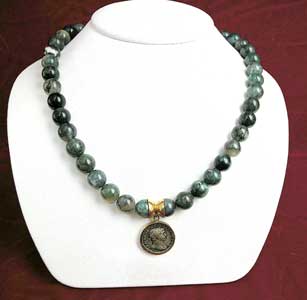Sivler Denarius of Roman Emperor Trajan, 98 CE - 117 CE
Silver-Agate-Gold
FJ.5151
Further images
This stunning silver coin is set in a lovely 18 karat gold pendant, strung on a necklace of genuine moss agate beads, with an 18 karat gold clasp. C. Messius...
This stunning silver coin is set in a lovely 18 karat gold pendant, strung on a necklace of genuine moss agate beads, with an 18 karat gold clasp.
C. Messius Quintus Trianus Decius was born about 201 A.D. In lower Pannonia (now Hungary and Yugoslavia). He was governor of lower Moesia (southern Europe) from 234-238 A.D. Following the abortive rebellion of upper Moesia, Philip dispatched Decius to restore order; but the rebels forced the latter, under threat of death, to "assume the purple" and march upon Italy. In the ensuing battle Philip and his son were slain and Decius w as left undisputed master of the empire. Much of his short reign was spent in fighting the barbarians on the northern frontier and in a battle against the Goths in 251 A.D. Decius was defeated and killed. Unfortunately, the reign of Decius is best known for his rigorous persecution of the Christians, in which pope Fabian lost his life. Apart from Decius' own coins, and those of his wife and sons, he also struck a series of coins commemorating most of the deified emperors from Augustus to Severus Alexander.
Agate, a member of the quartz family formed in the recesses of volcanic rocks, is found in a variety of colors: red, green, blue, brown, gray and striped. Since Antiquity, agate has been one of the most popular stones for talismans and amulets, and remarkable powers are ascribed to each of the different varieties. The use of agate amulets has continued unabated into modern times, though early examples exist from the Sumerian and Egyptian cultures, dating back four millennia before Christ. In addition to jewelry, agate was carved into cups, dishes and works of art. The Roman naturalist Pliny records that pharmacists favored mortar and pestles crafted from agate, a practice which is still common. By far the most preferable of the agate gems is the brown, or "tawny" type. It is believed to cure an enormous number of ailments, including fevers, epilepsy, schizophrenia, intestinal troubles. rheumy eyes and difficult menstruation. It is a good antidote for poison, and is said to quicken the intelligence. Green agate is excellent for quelling eye diseases and preventing sterility; blue cures depression and sleeplessness; gray or white prevents neck problems and stomach upset; while red (or blood) agate was used by the Ancients as an antidote to poisonous insect bites and other ailments spread through the circulatory system. All varieties of agate are useful for curing insomnia and inducing pleasant dreams and are thought to have a universally positive effect on those who wear them.
C. Messius Quintus Trianus Decius was born about 201 A.D. In lower Pannonia (now Hungary and Yugoslavia). He was governor of lower Moesia (southern Europe) from 234-238 A.D. Following the abortive rebellion of upper Moesia, Philip dispatched Decius to restore order; but the rebels forced the latter, under threat of death, to "assume the purple" and march upon Italy. In the ensuing battle Philip and his son were slain and Decius w as left undisputed master of the empire. Much of his short reign was spent in fighting the barbarians on the northern frontier and in a battle against the Goths in 251 A.D. Decius was defeated and killed. Unfortunately, the reign of Decius is best known for his rigorous persecution of the Christians, in which pope Fabian lost his life. Apart from Decius' own coins, and those of his wife and sons, he also struck a series of coins commemorating most of the deified emperors from Augustus to Severus Alexander.
Agate, a member of the quartz family formed in the recesses of volcanic rocks, is found in a variety of colors: red, green, blue, brown, gray and striped. Since Antiquity, agate has been one of the most popular stones for talismans and amulets, and remarkable powers are ascribed to each of the different varieties. The use of agate amulets has continued unabated into modern times, though early examples exist from the Sumerian and Egyptian cultures, dating back four millennia before Christ. In addition to jewelry, agate was carved into cups, dishes and works of art. The Roman naturalist Pliny records that pharmacists favored mortar and pestles crafted from agate, a practice which is still common. By far the most preferable of the agate gems is the brown, or "tawny" type. It is believed to cure an enormous number of ailments, including fevers, epilepsy, schizophrenia, intestinal troubles. rheumy eyes and difficult menstruation. It is a good antidote for poison, and is said to quicken the intelligence. Green agate is excellent for quelling eye diseases and preventing sterility; blue cures depression and sleeplessness; gray or white prevents neck problems and stomach upset; while red (or blood) agate was used by the Ancients as an antidote to poisonous insect bites and other ailments spread through the circulatory system. All varieties of agate are useful for curing insomnia and inducing pleasant dreams and are thought to have a universally positive effect on those who wear them.





